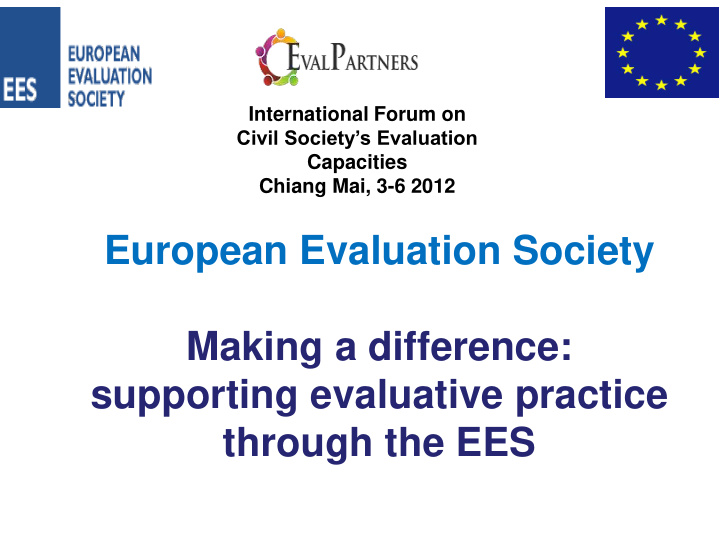



International Forum on Civil Society’s Evaluation Capacities Chiang Mai, 3-6 2012 European Evaluation Society Making a difference: supporting evaluative practice through the EES
Background • Founded 1992: The Hague • Emerging professional needs of individuals • Academics and auditors • The Board has 12 possible members, 8 elected • Ex President a member for one year
The mission • The goal of the European Evaluation Society is to stimulate and promote theory, practice, and utilisation of high quality evaluation especially, but not exclusively, within Europe.
Membership: 488 individual members and 30 institutional • academics (30%), • free lancers (18%), • private consultancy workers (22%) • evaluation commissioners and evaluators at governmental institutions (8%), • supranational (3%) • international organizations (11%), • NGOs-Non-profit institutions (7%). May 2012, 82% conduct and/or do evaluation, 42% teach evaluation, 43% carry out research on evaluation, 31% commission and/or manage evaluations, and 4% are students. The disciplinary composition of members is 15% Public Administration, 15% Economy, 13% Political Science, 13% Sociology, 10% Education, 7% Business Administration, and engineers, social workers and psychologists (3% each one; other categories 15%).
NESE (Network of Evaluation Societies in Europe) At the EES Conference in Berlin (2004) The structure that emerged placed the EES as a core partner and with one other European society or network as co-coordinator for a two year term. To date the NESE co-coordinators along with the EES have been the SFE (The French Evaluation Society), DeGEval (The German Evaluation Society) and the Italian Evaluation Association
Strategy: The enabling environment Promote national evaluation societies in Europe with a view to strengthen the evaluation culture of national governments and the civil society Statement on Ethics and Standards in 2004 Evaluators ’ capabilities framework that was validated through two surveys (2009, 2011) Statement on impact evaluation in 2007: “The importance of a methodologically diverse approach to impact evaluation”.
Developing/strengthening individual capacities • High quality training in biennial conferences: pre-conference workshops • International master classes on specific themes (Odense in 2009 and Seville 2007) • Other evaluation events in non-conference years • USPE group university based programmes in evaluation • Student reduced membership and conference fee and special student award • Collaboration with the Journal Evaluation .
Strengthening equity-focused and gender-sensitive evaluation systems and evaluations • Influencing through the development of Thematic Working Groups ( TWGs). “Gender and Evaluation”, “ Evaluation of International Engagement in Fragile Situations” • sessions on gender issues, at conferences • The EES Board is attentive to gender balance. • Bursaries for evaluators in developing countries to attend its biennial conferences
Institutional capacity (1) Professionalization of EES secretariat services EES Board meetings which are mainly held virtually, to save costs. A typical array of groups and activities are: • Conference • TWGs around general areas of strategic interest. • Members’ services • Newsletter- ‘Connections’ • Professional development and capacity building • Communications • Non- conference years and ‘ad - hoc’ events • Relations with the Evaluation journal • Recruitment and fund raising
Institutional capacity (2): knowing the membership • Analysis of the community and membership as a priority • Surveys also as a tool which enables communication and getting active participation from members and for getting useful information on members • In 2011, ‘Individual Member Profile’ in the Member Area of the web site . • The EES will continue with more ‘in - depth’ analysis of its membership
Bottlenecks/challenges • Relatively small membership which fluctuates depending on conference years • Need for a stronger ownership and a more substantial participation of members in the society: not a service provider • Need to utilize more efficiently Social Networks and new IT’s allow • The EES as a regional-supranational player; challenge of developing an ‘European Evaluation Space’. NESE is grappling with this issue.
Progress • Biennial conferences • Developing events • Thematic working groups • Improved secretariat and service provider • Communication • Membership policy
Enabling factors • Regional positioning • Strong partners • Dedicated four-year term Board • Professional secretariat • EU contacts
Innovations and lessons learned • Dedicated plan of activities; BM working plans • Using social and other communication media • Strategic partnerships • Strategic thinking space and clear vision
Next steps Increasing membership (participatory approaches) Communication strategy TWG strategy Donors within EU Building EES historical archive
Recommend
More recommend